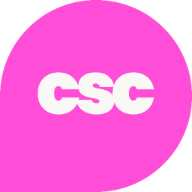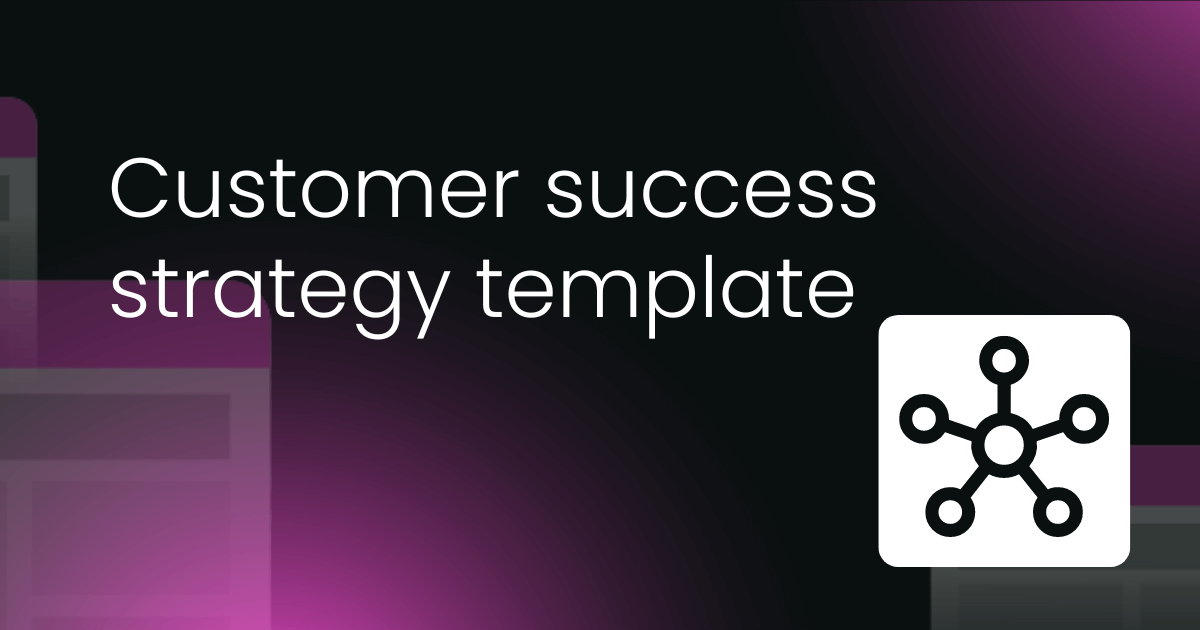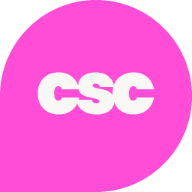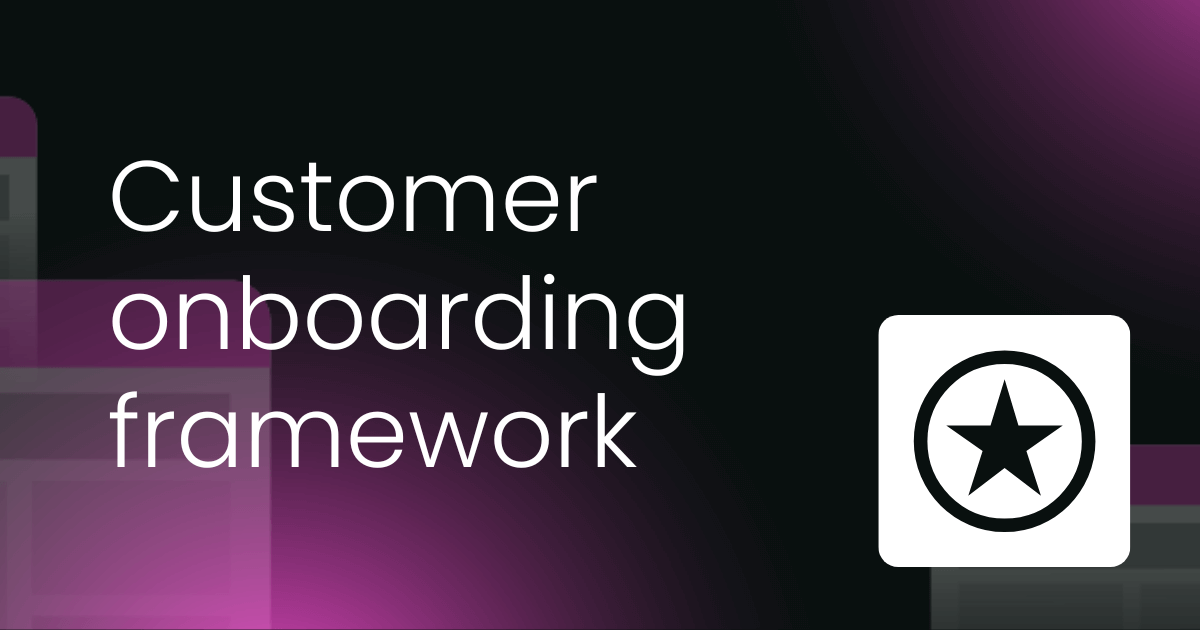If you want to build a business that gives your customers exactly what they want, then you need to make customer success a priority.
When done properly, customer success can enhance a number of different parts of your business, especially customer satisfaction, loyalty and retention. It also helps bolster your brand image and inspires your (happy) customers to spread the word far and wide about your must-have offering.
Customer success is crucial for companies with a customer-first approach looking to compete and succeed in the modern market, and those who understand this reap the rewards.
In this article, we explore the ins and outs of creating a complete customer success package, namely:
- What customer success is
- The key foundations of customer success
- Why customer success should be viewed beyond its department
- What customer onboarding is
- What value realization is
- The difference between customer success and customer satisfaction
- The main differences between customer success strategies and traditional customer support
If you aren't making the most of a fully-comprehensive customer success strategy, you could be left in the dust by your competitors as they steam ahead, taking your customers with them. More than 70% of businesses say improving customer success is their top priority, so don’t get left behind.
But first, let’s unpack what customer success actually is, and how it differs from something like customer satisfaction or customer support.
What is customer success?
The basic definition of customer success is simple: giving your customers exactly what they want. Instead of just treating your customers as cash cows, your products and services should be aimed at helping your customers achieve their goals and solve their problems.
But customer success doesn't begin and end with your products. While creating products (or services) that solve your customers' problems is essential, everything you do should be steered by a firm understanding of what your customers actually need or want.
For example, your website layout should enable customers to find what they want easily and eliminate any potential hiccups or bottlenecks that could be experienced along the way. Your sales funnels and processes should do the same; the aspect of your marketing function should be built with customer success in mind.
Your customer service practices should also be built with customer success in mind — something we'll look at more closely in just a minute.
In a nutshell, your main goal as a business should be helping your customers reach their intended goals they set out to achieve when purchasing your product.
Let's say your product is a social media scheduling platform; your customers' goals would be to be able to seamlessly schedule and post on Twitter, Facebook, LinkedIn and Instagram.
A satisfied customer turns into a loyal one, which opens up the possibility of revenue growth. A satisfied customer is one who will not only sing your praises and extend your brand reach and word-of-mouth marketing organically, but will be open to paying more for additional services and new levels of your product (upselling and cross-selling).
What are the key foundations of customer success?
- Building strong relationships with customers
- Understanding exactly what your customers want (and giving them more of it)
- Making sure your products and services are easy to implement and designed with the user in mind
- Helping your customers achieve all their goals (and more)
Now let’s go a little bit deeper into the magic ingredients that make customer success work.
Building out customer success beyond the department
Before you get into onboarding, churn, or retention, it's becoming increasingly clear that customer success shouldn't just be an afterthought that kicks in after the point of sale. If customer success is just a post-sales motion, you’re seriously missing a trick. Customer success isn’t just a department. It isn’t just a team in your company. Being customer-centric and focusing on your customers’ success is a business-wide philosophy.
Now, imagine CS as a key player right from the start, even before a deal is sealed. Think of CS professionals as consultants during those initial discovery calls. They're there alongside the sales team, not just to support but to offer valuable insights into what customers really need and how they've interacted with products in the past.
This shift in perspective transforms CS from a mere post-sales function to a strategic partner in the entire sales process. It's like giving the customer experience a head start, making sure that every step, from the first “hello” to the final handshake, is tailored to what the customer truly wants.
And it doesn't stop at sales. When CS gets involved in areas like product development and marketing, they bring a wealth of customer insights to the table. They know what customers love, what they need, and even what they're missing before they know it themselves. This knowledge is gold for creating marketing messages that hit home and developing products that customers can't wait to use.
In this way, CS isn't just a department; it's a holistic strategy that threads through the entire fabric of a business, keeping it closely knit to the customer's journey and experience.
Customer onboarding
Customer onboarding is the crucial bridge between closing the sale and the customer's initial experience with the product or service. It plays a vital role in ensuring a smooth transition from the sales process to the actual use and adoption of the offering. Think of it like a first date after a great chat online; this is where you really start to build a lasting relationship.
Now, if you nail this onboarding phase, making it smooth and engaging, you're setting the stage for a strong partnership. Your customers will stick around, and they might even be keen on exploring more of what you have to offer. But, if you rush through it without giving them the guidance they need, it's like leaving them in a maze without a map. And that's when satisfaction dips, and you might start seeing them head for the exit.
This phase is all about first impressions, setting the tone for either a successful partnership or, sadly, a missed opportunity. It's like a litmus test for how the rest of your relationship will pan out.
Elements of successful customer onboarding
No onboarding process is complete without product tours, an immersive experience that takes users on a journey, demonstrating real-world use cases and showcasing the tangible benefits they can expect.
The same goes with checklists and how-to guides – these customer education resources are just what you need in your arsenal to ensure your customers are fully clued up with your product's capabilities.
When you're onboarding a customer, you can facilitate their education and familiarization with a vast array of mediums, like email, live onboarding sessions, and in-app messaging.
Think like your customer
When you're designing your onboarding experience, it's crucial to walk a mile in your customers' shoes. Run your team through it and see where you can sprinkle in some extra value, confidence, and efficiency. At every step, ask yourself: "Are we really showing how valuable this is? Are we easing any worries they might have?" That's your golden ticket to an onboarding process that hits the mark.
Remember, your product, marketing, and sales teams have already done the heavy lifting getting prospects through the door. But without a captivating onboarding process, all that effort might just fizzle out.
Onboarding is your chance to make your product come alive for the customer. They've seen the previews, they've heard the pitches, but now it's real. And it's up to you to make sure that reality is as brilliant as they hoped it would be. That's where customer success steps in, turning that initial excitement into long-term engagement and value.
Value realization
Value realization in customer success is almost like the secret sauce that makes everything in customer relationships click. "Value" is all about defining and delivering the true worth of your product or service. It's not just a buzzword; it's the real deal in ensuring your clients grasp the full benefits of what they've signed up for.
Imagine you're a Customer Success Manager juggling various projects and clients. Your main gig? Getting your clients to quickly see and experience the value of what they’ve bought into. It starts with clearly laying out what the positives are – think of it as a value statement that guides everything you do.
So, how do you get there? It's all about crafting a plan that moves the needle toward realizing this value. This plan isn't just a roadmap; it’s your playbook for customer success. It involves setting clear goals, celebrating every small win, and keeping communication transparent and frequent. Your aim? To keep everyone on the same page and build trust.
What's difference between customer success and customer satisfaction
While the two are undoubtedly related, they aren’t one and the same. Customer satisfaction is important, but to really take things to the next level, you don't just want your customers to be satisfied, you want them to be more than satisfied.
As we’ve already established, customers don't always know what they want. If you just give them what they think they want, it might not solve all their problems. With customer success, you need to explain to them what they need and more. Go the extra mile to help customers reach their goals.
Simply offering a great sales experience is good in the short term, but if your products aren’t up to scratch, it will only be a fleeting victory (and won’t transform first-time customers into loyal brand advocates).
So a customer might be satisfied if they found your website easy to navigate, your support staff friendly and your delivery options comprehensive. But if the product they bought only solved their basic needs and didn't deliver a complete solution, you're missing one of the oldest tricks in the book.
An effective customer success strategy will explain to your customer why they need more than they think they need, and why your products or services are the ones to plug the gap.
What are the main differences between customer success strategies and traditional customer support?
1. Customer success builds relationships
Customer success generally has a much broader reach for your business and has longer-term benefits (to both you and your customers) at its core.
The problem with customer support and satisfaction is that they're generally only transactional. They begin and end when a customer has a problem, and when it is resolved.
Customer success is different — it doesn't just end when you've solved a customer's problem. Customer success isn't defined by simply completing a support ticket, it's all about building a lasting relationship with your clients and visitors for as long as possible.
So a proper customer success strategy should be ongoing and it should evolve over time.
Another key thing to remember with customer success is that not all your visitors will be customers yet. Customer support only solves problems when someone has bought a product, and often when something has gone wrong. Building successful relationships within your business should start when someone first clicks on your website or gets in touch with you. The strongest customer relationships begin even before someone becomes a fully-fledged customer.
Customer service is generally only reactive; you can build a great support system but it's often only going to be put to use if customers have a problem. It's better for you, and your customers, if there are never any problems. That's why building an ongoing and evolving customer success strategy is so important.
2. Customer success is proactive
We touched on this earlier but it really is vital to stay on your toes when it comes to customer success. Don't just wait for customers to come to you with a problem.
How about reaching out to all your customers a few days after they've bought your products or services? Ask them if they've got any issues, or if there's anything they need help with. This is huge, as most customers will keep quiet if they weren't completely happy or had a problem. Worse still, some of them will keep quiet, and simply never return to your business again.
You need to be proactive in providing support for your customers. It'll help build loyalty toward your business and help encourage repeat sales.
Always make sure you're aware of your customer's goals and adapt quickly to help them reach them. This starts with creating products specifically for them, but also in explaining why they need what you have to offer. And it continues after a sale, to make sure they got exactly what they wanted and if not, where you could improve.
3. Customer success has a wider view of positive impacts on your entire business
As we covered earlier, customer support tends to begin and end with a support ticket. So any improvements to your support services will be aimed at improving response times and making sure the quality of help people receive is good. These things definitely shouldn't be ignored but customer success has a broader focus on your customer's entire journey and how this will impact your progress further down the line.
When improving customer success, you should look to measure things like retention rates as well as upselling and cross-selling opportunities.

4. It can be harder to measure ROI with customer success
While there are loads of benefits to creating a compelling customer success strategy, some of its impacts can be hard to measure. It's easy to know the cost of your customer support services, and measure ROI effectively, but knowing how much your improved customer success strategies helped can sometimes require a bit more thought.
One of the reasons for this is that customer success is a much newer idea in the business world; it hasn't been fully explored yet. While this can make measuring success difficult, it also presents one key opportunity for you as a business owner or manager: you can get ahead of the competition by treating it as a priority when other competitors might not be.
Even though measuring ROI can be difficult when it comes to customer success, there are a few key metrics you should keep a keen eye on. This includes things like:
- Increased referrals from existing customers
- Brand mentions
- Improved retention rates
- How many existing customers use your products on a day-to-day basis
When you start spending time and money on improving your customer success strategies, you should notice most of these improvements over time.
5. Recruiting
As customer success is a much newer idea than support and customer service, finding the right staff to implement the best ideas might not be as straightforward. The market for staff in customer service is huge, it's an established industry that has been around for decades. That means there isn't necessarily one definitive answer on the right type of staff to look for with customer success in mind.
To recap
As you can hopefully see by now, although there are some gray areas when it comes to developing a successful customer success strategy, it's still something that can be hugely beneficial to the growth of your business.
It's something you can't really afford to ignore anymore. The best strategy combines both customer success and customer support seamlessly, to glean the best possible results.
Customer success is here to stay, and it's something you can get ahead of the field by implementing immediately. It'll be good for your customers, and ultimately great for your business.

Re-familiarize yourself with the essentials of customer success
Looking for a well-rounded course that teaches the fundamental properties of customer success? Then look no further.
Accelerate your customer success career with the most cutting-edge and comprehensive curriculum around, and walk away with new knowledge, tried and tested strategies, and a competitive edge.
By the end of the course, you'll:
🧠 Understand the full breadth of the CS function.
💪 Be armed with all and only the most up-to-date and successful CS tactics and trends.
📈 Up-skill yourself in every core competency required for your role, and prove your strategic value.
🏆 Tap into the proven strategies used at some of the world’s most innovative and established brands.
🔖 Earn an official certification to boost your resumé and accelerate your career.



 Follow us on LinkedIn
Follow us on LinkedIn









